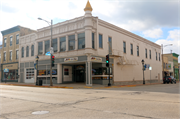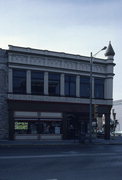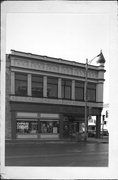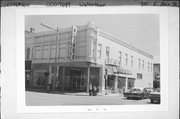Property Record
301 E MAIN ST
Architecture and History Inventory
| Historic Name: | PLATZ AND BRANDT BUILDING |
|---|---|
| Other Name: | BEN FRANKLIN STORE |
| Contributing: | Yes |
| Reference Number: | 7089 |
| Location (Address): | 301 E MAIN ST |
|---|---|
| County: | Jefferson |
| City: | Watertown |
| Township/Village: | |
| Unincorporated Community: | |
| Town: | |
| Range: | |
| Direction: | |
| Section: | |
| Quarter Section: | |
| Quarter/Quarter Section: |
| Year Built: | 1876 |
|---|---|
| Additions: | C. 1905 1986 |
| Survey Date: | 20052020 |
| Historic Use: | large retail building |
| Architectural Style: | Romanesque Revival |
| Structural System: | |
| Wall Material: | Cream Brick |
| Architect: | James Kersbergen |
| Other Buildings On Site: | |
| Demolished?: | No |
| Demolished Date: |
| National/State Register Listing Name: | Main Street Commercial Historic District |
|---|---|
| National Register Listing Date: | 6/2/1989 |
| National Register Multiple Property Name: |
| Additional Information: | Previously surveyed in 1986. This building was constructed for the historic Platz and Brandt store. Platz and Brandt was here between the 1870s and the 1930s. The store eventually became the Brandt and Abele store and from about 1907 on, it was known as the W.F. Brandt and Son store, and had expanded next door. Frederich W. Brandt was the founder of this store. He was a German immigrant who came to Watertown in 1853. reportedly the first drayman in the city, he established a general store known as the Platz and Brandt store in 1864. In 1889 the business became the Brandt and Abele store, and in 1900, W.F. Brandt became sole owner of the store upon the death of his father, Frederich W. Brandt. Soon after this, W.F. Brandt's son, W.E., entered the business as well. In 1917 the W.F. Brandt store was a large general of department store employing 20 to 30 people. This building has significance for local history under National Register criterion A because it housed the important Brandt store, a long-time and successful department store. Next to Schempf's store, the next largest and most significant of the dry goods-department stores in Watertown was the old Platz and Brandt store, later the W.F. Brandt and Son store. The Brandt family was an old German immigrant family who achieved not only commercial success in W.F. Brandt, the son of Frederich, but also achieved success in the other son of Fredrich, Edward J. Brandt, the banker who invented a coin handling machine and became a leading industrialist in the community. Brandt's store reflects this family's success and prestige in the community. This building is also significant for its contribution to the overall development of commerce in the Main Street Commercial Historic District. Built as early as 1867, the metal covered facade of the Platz and Brandt General Merchandise Store displays a round corner turret with a conical roof and paneled diagonal stripped shaft over an open corner entrance supported on the northwest corner by a square column. Further ornamented by a plain projecting cornice and arcaded frieze that is visually supported by capped square columns, this building also had a paneled parapet extending above the cornice vertically divided by short square brick piers. Another plain cornice projecting above the second story windows is visually supported by decoratively capped fluted square columns used as window mullions that are based in the band of raised decoration extending across the north and west facade above the storefront. A brick cornice featuring a blind arcade and plain rectangular windows with flat straight stone lintels characterize the west elevation. An exterior metal fire escape hangs on the west elevation. Originally a cream brick late 1860s building, the Brandt store and the facade was remodeled in the Romanesque Revival style at the beginning of the 20th century. In 1985, the Platz and Brandt Building was altered by the replacement of the original windows with large modern sheets of glass. Also during the 1985 remodeling project, the display windows on the west elevation were closed while interior changes included new ceilings and lights and the elimination of the large stairway. The exterior surface was altered when it was cleaned by sandblasting. The Platz and Brandt Store building is significant under criterion C as an example of the Romanesque Revival style. Exhibiting a plain projecting cornice and fluted pilasters more commonly seen in the Neo-classic style, the facade of this rather eclectic building is characterized mainly by the blind arcade that defines the attic store, the corner turret decorated with geometric textured moldings and the foliated band of decoration forming the base of the second floor that is associated with the Romanesque style. Although the storefront was remodeled during the 1986 renovation of the building by architect James Kersbergen, the storefront is visually in keeping with the historic architectural character of the building. The Platz and Brandt Store is the best example of the Romanesque Revival influence remaining in the Main Street Historic District. Although no other building is dominated by the Romanesque style, several vernacular buildings such as the Buchheit buildings at 114 and 116 South 3rd St. and the Hepp building at 11 E. Main exhibit some Romanesque Revival influence. Built for Platz and Brandt in the late 1860s to house their general merchandise business, this building has expanded several times, incorporating several small buildings on the east side into the space presently used by the Ben Franklin Store. This building received its Romanesque Revival metal covered facade in the first decade of the 20th century. |
|---|---|
| Bibliographic References: | (A) Wisconsin State Journal March 7, 1985; Sept. 11, 1986; Oct. 16, 1995. (B) Tax Records, City of Watertown, 1860-1910, Area Research Center, Library, University of Wisconsin-Whitewater. (C) Sanborn Insurance Maps 1884, 1901, 1909. (D) Watertown City Directories, 1866-1930, Watertown Public Library. (E) John H. Ott, Ed., Jefferson County Wisconsin and Its People, Chicago: S.J. Clarke Publishing Co., 1917, p. 182-183. (F) "Watertown Special Edition.," The Jobber and Retailer, Vol. 5, No. 5, August 1909, on file at the Watertown Historical Society, Octagon House, Watertown, Wisconsin. |
| Wisconsin Architecture and History Inventory, State Historic Preservation Office, Wisconsin Historical Society, Madison, Wisconsin |





